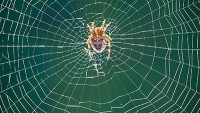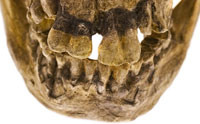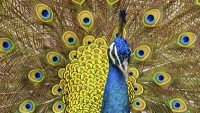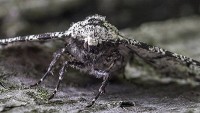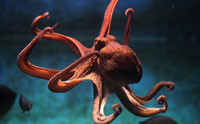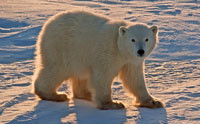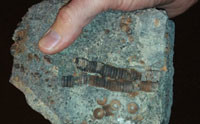The tiny fruit of a plant lands a big blow against evolution. …read more Read more here: creation.com
By Ken Ham According to this researcher, as humans supposedly evolved, we lost the need for bigger brains dedicated to out-smarting others. Instead, goes the story, we developed smaller brains wired to be social and to gossip. Since social media provides the perfect outlet for gossip, it comes as no surprise to this researcher that many people “have a compulsion to engage with lots of people via social media” because “our brains have evolved for us to be social animals.” It seems that evolution takes the credit, or the blame, for everything these days. Behaviors and choices—from social …read more [More]
Do common mutations found in humans and apes prove evolution? …read more Read more here: creation.com
By Dr. Gordon Wilson Next time you’re tempted to brush away a spider web, stop to consider the engineering required . . . and the Engineer behind the engineer. …read more Read more here: AIG Daily
By Michael Cargill The molecular complexities of staphylococci mechanisms indicate the signature of a divine Designer who has placed his signature on his art piece, staphylococci. …read more Read more here: AIG Daily
Secular scientists have told incredible stories for over a century about how fossil teeth supposedly support the idea that humans evolved from primates. A lack of knowledge about tooth development has provided fertile ground for wild speculations about evolving tooth sizes, skull shapes, foot shapes, and even life habits. A new report changes all that conjecture. More… …read more Read more here: icr.org
By Devon Spencer, DVM As researchers sequence the DNA of more organisms, they find species (like the red wolf) they called unique physically are not so unique genetically. …read more Read more here: AIG Daily
Why evolutionists try to explain such chemistry wouldn’t exist until over 100 million years later. …read more Read more here: creation.com
The idea that plant breeding supports evolution doesn’t stand up to scrutiny. …read more Read more here: creation.com
The incredible complexity of feathers continues to puzzle evolutionists. …read more Read more here: creation.com
Sneak peek of latest Creation magazine. The 2015 Nobel Prize for Chemistry highlights that DNA would be useless without the repair mechanisms to preserve it. …read more Read more here: creation.com
By Dr. Elizabeth Mitchell Researchers believe the 8-million-year age assigned to some gorilla teeth pushes back the time for the divergence of gorillas from the line that led to humans. …read more Read more here: AIG Daily
Can secular journals get away with mentioning a ‘Creator’? No way! …read more Read more here: creation.com
By Prof. Andy McIntosh Richard Dawkins sought to justify an idea of gradually producing flight, but showed little understanding of the engineering principles involved in aerodynamics. …read more Read more here: AIG Daily
By Dr. Gary Parker There are literally thousands of examples of the unique adaptations that suit each type of organism for its special role in the web of life. …read more Read more here: AIG Daily
By Dr. Elizabeth Mitchell Analysis of newly discovered deep-sea species led evolutionists to say that Xenoturbella, resembling a discarded purple sock, can help us understand evolution. …read more Read more here: AIG Daily
The idea that chimps can learn to speak as humans do has been thoroughly debunked. …read more Read more here: creation.com
By Dr. Gary Parker Studies have shown that essentially all 180 organs once listed as evolutionary vestiges have significant functions in human beings. …read more Read more here: AIG Daily
The amazing octopus continues to astonish scientists. “Octopuses are highly intelligent creatures,” says Claire Little, a marine biologist at the Weymouth Sealife Center in southwest England. “They are classed as intelligent as the general home pet dog.” Scientists recently sequenced the octopus’ genome and found it’s nearly the size of the human genome. More… …read more Read more here: icr.org
By Dr. Nathaniel T. Jeanson Some biblical creationists have fallen into the evolutionists’ trap and tried to refute evolution by throwing out the concept of natural selection entirely. …read more Read more here: AIG Daily
By Dr. Gary Parker Why should a person’s arm have the same kind of bone pattern as the leg of a dog and the wing of a bat? There are two basic ideas. …read more Read more here: AIG Daily
By Dr. Elizabeth Mitchell Three of the genes that control our immune system’s first line of defense (and our allergies) bear a significant footprint from Neanderthals. …read more Read more here: AIG Daily
Researchers have uncovered scientific evidence that the human brain recognizes the existence of God. Scientists have discovered that the reality of God is hardwired into the human brain — even by those who are not taught directly taught about Him — according to new research divulged by National Geographic. Global Neuroscience Initiative Foundation Executive Director Shaheen E. Lakhan, who holds numerous doctorate degrees, including an M.D. from the Technion-Israel Institute of Technology, contends that something that has been revealed by the Bible for millennia is now recognized by modern science. Read More: Research: Brain recognizes reality of God
Namib desert beetles collect faint water droplets on their exquisitely designed outer surfaces so they can survive in their dry environments. And polar bears keep a tight grip on smooth ice using precisely designed footpads. Engineers have copied these exquisite designs to make useful tools. More… …read more Read more here: icr.org
By Dr. Gary Parker It’s what we do know and can explain about DNA and protein and the laws of chemistry which suggests that life itself is the result of special creation. …read more Read more here: AIG Daily
The Deep Down Under project explores “relict faunas,” living creatures with eerily similar counterparts among some of the world’s oldest fossils. Deep-sea researchers used a remotely operated vehicle (ROV) to look for life around Osprey Reef off Queensland’s coast. They found some surprises including animals known only from faraway places and long-gone times. More… …read more Read more here: icr.org
By Dr. Elizabeth Mitchell If a computer simulation can trace a path for the evolution of multicellular organisms from single-celled ones, does that mean they actually evolved that way? …read more Read more here: AIG Daily






















